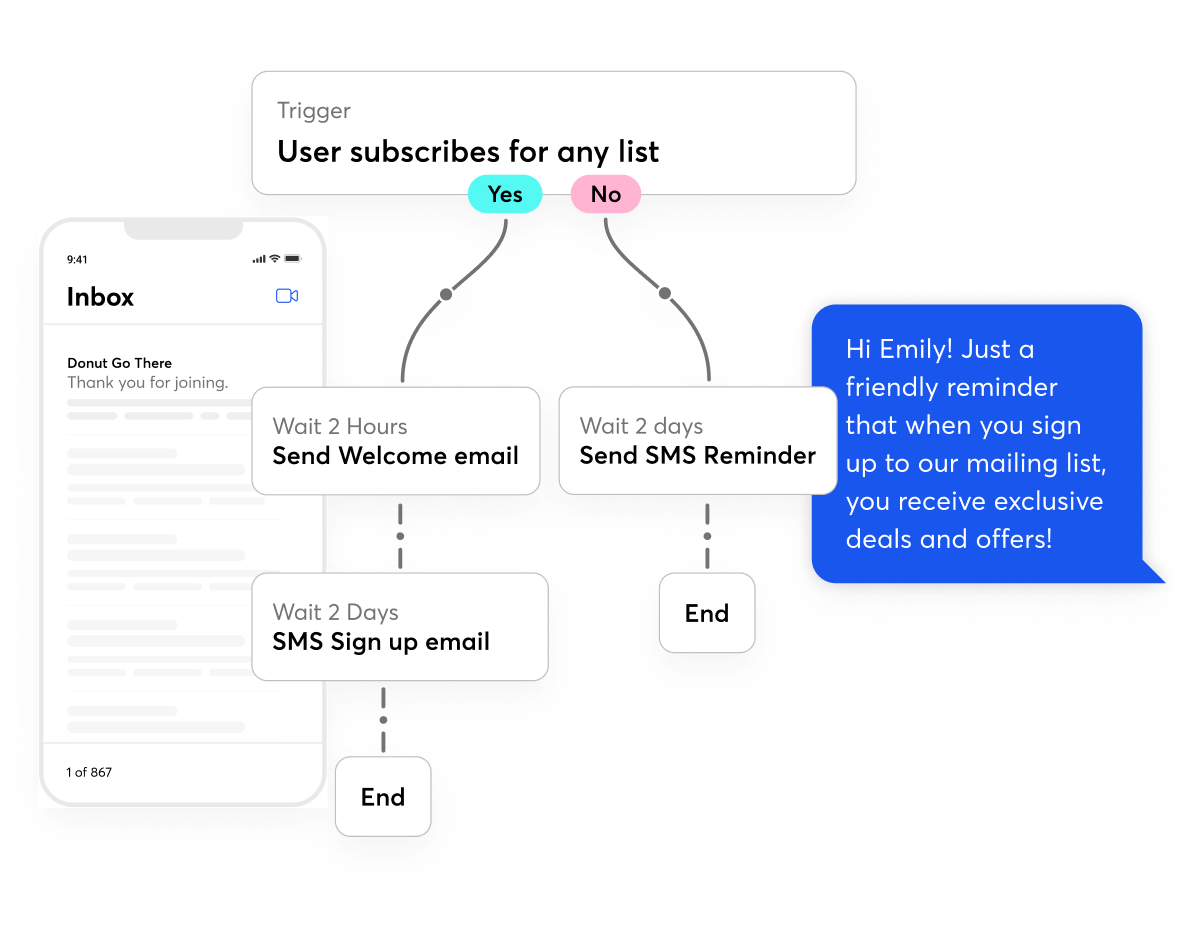Get results instantly with social and email marketing automation.
More revenue in less time with automated messaging.

Increasing engagement is easier than you think.
Say hi.
Make a good first impression with every new contact who interacts with your brand by greeting them with a welcome email.
Nurture leads.
Create automated messaging paths to engage with your contacts over time.
Create your own path.
Map out the “who, what, and when” of your messaging and let automation manage your marketing.

Put your messaging on autopilot.
Focus on your business with confidence, knowing your emails and texts will be delivered to the right person at the right time, automatically. Get started today with plug-and-play path templates Explore more: Get Inspired With Automation Examples
Marketing Automation made easy.
Start from scratch or select from a library of plug-and-play templates to send the right message at the right moments.


Welcome email.
Send an automated welcome email or text to new contacts, then build your relationships overtime with a messaging cadence and quality that adapts to how subscribers interact with previous content.
Birthday and anniversary emails.
Keep subscribers engaged with your brand by sending them a birthday or anniversary message via email or text to let them know they're important to you.


Resending emails.
Looking to improve results? Change the subject line to try a different message and resend to contacts who didn’t open your first email.
Explore more : How Resending an Email is Good for Business
List-building tools.
Use our list-building tools and sign-up forms to attract new contacts on your website, Facebook, through text, and more. Grow your list and grow your business.

Level up your emails with popular apps and integrations.
Add Shopify directly into your emails and send automated emails to first-time customers. Capture new subscribers with Facebook Lead Ads and nurture leads with automated welcome emails. We have hundreds of apps to choose from.
Frequently Asked Questions
Email marketing automation is a magic wand for your marketing strategy. With the ability to pre-plan email sends based on audience data and behaviors, email marketing automation puts time and money back into your business while improving customer satisfaction. To illustrate the benefits of email marketing automation, let’s start with an example. Say you want to introduce your business to new subscribers — you’ll want to create an automatic trigger to connect to your email sign-up form. Once the form-filler completes and submits the form to join your email list, an automated action will send them a welcome email. Introducing email marketing automation into your marketing strategy will allow you to generate more leads, increase revenue, and retain customers with less manual effort. In fact, 30 percent of professionals surveyed said the biggest benefit of marketing automation was the time it saved them.
As your business grows, you want to spend more time on the big picture and less time on manual tasks. Email marketing automation allows you to deliver the same great experience for your first email subscriber and your 10,000th email subscriber — creating a seamless customer experience that promotes engagement and conversion.
Everything that’s quality takes time and effort — keep this mindset as you start your journey into email marketing automation. You’ll need to put in some elbow grease by planning out a workflow that makes sense for your business and your customers. To make the process easier, start with your end goal and work backward to find the beginning of your automation path.
Email marketing automation is a subset of marketing automation - meaning it is only one of the many areas where your marketing strategy can benefit from automation technology. While marketing automation is an umbrella term, email marketing automation hones in on all the niche efforts involved in helping your email marketing run as efficiently and effectively as possible. Email marketing automation follows a similar process to other marketing automation efforts in that it starts with a goal and requires you to identify the behaviors, interests, and needs of your audience. Once you have identified those factors, you can use them as criteria to craft action triggers for email content.
When you know the goal of your email campaign, choose the order, frequency, and targeted content of the messages you want to send. Once you build the email workflow sequence and set action triggers, your emails will send automatically. Check out this handy video our Knowledge Base team put together to help get started.
Use the following email automation examples to help you get started on building automated email campaigns.
Welcome series
Make a good first impression, build brand awareness, and turn prospects into customers by crafting an automated welcome series. Create a trigger action to send a welcome email or welcome series after prospects complete a sign-up form. Use your welcome email or series to introduce your brand, products, and services to subscribers.
Abandoned cart
Often, customers will commit the greatest tragedy against small business support — abandoning their carts before purchasing. Create an automated abandoned cart email to remind customers of what they left behind and win back revenue for your business.
Birthdays, anniversaries, and Special Occasions
Let your customers know you value them by sending them special offers and messaging for their birthdays, anniversaries, and other special occasions. Consider adding input fields to your sign-up form to collect birthday information and then use the data as the trigger date.
Newsletter and blog updates
Make sure your customers aren’t missing out on valuable information and updates. Keep your customers and prospects informed about what’s new with your business through automated email newsletters, and share ideas and advice by collecting your most recent blogs into a curated blog email.
Promote events and webinars
Events and webinars help your business build your list of prospects, reinforce loyalty, and showcase your expertise. Create an action trigger to link to your event invitations to send confirmation emails, reminders, and follow-ups to keep your attendees informed.
Ready to get started?